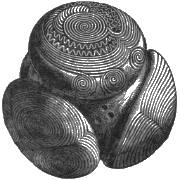NMS Archaeology Object 14526: H.KE 14 - Reliquary
Description
Summary
Monymusk Reliquary consisting of a rectangular casket and lid in the form of a roof, made from wood, copper alloy, silver, enamel and blue glass, decorated with intertwined animals, and possibly once containing a relic of St Columba, from around the 8th century AD
Accession Number
H.KE 14
Other references
| Archaeology Classification Number Archaeology Register Number HAAQ Register Number | X.KE 14 X.1933.2482 H.1933.2482 |
|---|
Original description
The Monymusk Reliquary. Dimensions = 112 x 51 x 89 mm. Cleaned at Conservation lab 1982. Caption note, February 1993: Decoration is c. 700, wooden box is older. Considered to be the Brecbennoch of St Columba, which a charter of William the Lion granted to the Abbey of Arbroath. Caption note, March 1993: It consists of a wooden box cut out of the solid covered with bronze plates, a silver one on front incised with intertwined animals, and gilt ornaments. One enamelled hinge for a carrying strap survives. It was made in Eastern Scotland about 700 and may either have contained a relic of St Columba or have been a pyx for carrying about the host after consecration. Shortly before 1211 it was given to the Abbey of Arbroath by King William the Lion together with the lands of Forglen, Banffshire, on condition that the monks should do service with the army. In 1314 the Abbot, Bernard de Linton, also Chancellor of Scotland, was present at the Battle of Bannockburn. Seven months later he transferred the Brecbennoch with its lands and duties to the family of Monymusk, Aberdeenshire. Purchased from the Grants of Monymusk, 1933. SCRAN CAPTION RECORD, 25-04-1997: RELIQUARY KNOWN AS THE 'MONYMUSK RELIQUARY' Ref: H.KE 14 INTRODUCTION - This portable reliquary, known as the Monymusk Reliquary, is one of Scotland's greatest treasures. It dates from around 750, and was an important object into the Middle Ages. This picture shows the front of the reliquary. DESCRIPTION - The edges of the reliquary are bound with tubular bronze fittings. Three round and three rectangular gilt bronze mounts were attached to the front but two have been lost. The central settings and sections of the borders of the mounts are in red enamel. BACKGROUND - The mounts on reliquaries of this type were richly decorated and elaborate objects. Viking raiders sometimes cut the mounts from looted reliquaries and re-fashioned them into other objects such as brooches. DETAILS - Date: Around 750 Material: Wood (yew), silver, bronze, gold, enamel, gemstone (lapis lazuli) Dimensions: Length: 10.8 cm;(Width: 49 mm) REFERENCES - Caldwell, D.H. (ed). Angels Nobles and Unicorns: Art and Patronage in Medieval Scotland. Edinburgh: NMS, 1982; Youngs, Susan (ed). 'The Work of Angels'. Masterpieces of Celtic metalwork, 6th-9th centuries AD. London: British Museums Publications Ltd, 1989, pp 134-5; Calder, Jenni. The wealth of a nation. Edinburgh: National Museums of Scotland and Glasgow: Richard Drew Publishing, 1989, pp 26, 74. NMS WEB HIGHLIGHT TEXT, 11-10-2006: This shrine is believed to be linked to St Columba, who brought Christianity to much of Scotland. Made around the 8th century AD, it shows how finely crafted objects were important to the Church. Although distinctively Irish in shape the ornament is characteristically Pictish. Some believe that the shrine is the famed Breccbennach, carried before Robert the Bruce’s army at the Battle of Bannockburn in 1314. With a wooden core the object consists of a rectangular casket and a hinged lid in the form of a roof . Thin sheets of metal cover the core: those on the lid and front are silver, the rest copper alloy.The interlaced animals set against a stippled background are characteristically Pictish. Breccbennach is Gaelic for ‘Speckled Peaked One’, which may describe the shape and decoration of the shrine. Whether the Breccbennach or not the Monymusk Reliquary is one of our most important treasures and is displayed prominently in the National Museum of Scotland. Alice Blackwell note, 21.04.2015: description corrected - reference to lapis lazuli removed and replaced with blue glass (confirmed by xrf analysis). The reliquary as survives is composed of 41 separate pieces, excluding the pins which hold components in place; when complete it was made from at least 56 pieces.
Associated person/people (e.g. excavator/former collection)
Saint Columba
Grant of Monymusk
Abbot Bernard de Linton
Discovery / field collection
Date of discovery
Not recorded
Method (e.g. excavation)
Not recorded
Place (i.e. location of discovery)
Grid reference
Not recorded
Acquisition
Acquisition date
1933
Acquisition source (i.e. name of donor)
Not recorded
Acquisition source role (e.g. donor)
Vendor
Image
Identifiers and Links to Other Records
Would you like to help find more links?
| Identifier / External Link | Linked Record | Status | Comment |
|---|---|---|---|
| Canmore Site Id: 18412 | MONYMUSK - FORGLEN - RELIQUARY | Definite | |
| NMS Accession Number: H.KE 14 | No linked record | Identifier supplied by NMS |
This area is visible only to logged in users.
